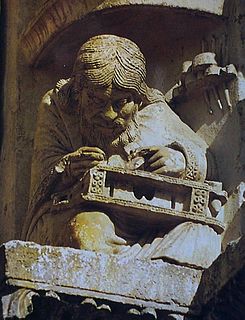 W
WEuropean science in the Middle Ages comprised the study of nature, mathematics and natural philosophy in medieval Europe. Following the fall of the Western Roman Empire and the decline in knowledge of Greek, Christian Western Europe was cut off from an important source of ancient learning. Although a range of Christian clerics and scholars from Isidore and Bede to Jean Buridan and Nicole Oresme maintained the spirit of rational inquiry, Western Europe would see a period of scientific decline during the Early Middle Ages. However, by the time of the High Middle Ages, the region had rallied and was on its way to once more taking the lead in scientific discovery. Scholarship and scientific discoveries of the Late Middle Ages laid the groundwork for the Scientific Revolution of the Early Modern Period.
 W
WMedieval technology is the technology used in medieval Europe under Christian rule. After the Renaissance of the 12th century, medieval Europe saw a radical change in the rate of new inventions, innovations in the ways of managing traditional means of production, and economic growth. The period saw major technological advances, including the adoption of gunpowder, the invention of vertical windmills, spectacles, mechanical clocks, and greatly improved water mills, building techniques, and agriculture in general.
 W
WThe Islamic Golden Age was a period of cultural, economic, and scientific flourishing in the history of Islam, traditionally dated from the 8th century to the 14th century. This period is traditionally understood to have begun during the reign of the Abbasid caliph Harun al-Rashid with the inauguration of the House of Wisdom in Baghdad, the world's largest city by then, where Islamic scholars and polymaths from various parts of the world with different cultural backgrounds were mandated to gather and translate all of the known world's classical knowledge into Syriac and Arabic.
 W
WScience in the medieval Islamic world was the science developed and practised during the Islamic Golden Age under the Umayyads of Córdoba, the Abbadids of Seville, the Samanids, the Ziyarids, the Buyids in Persia, the Abbasid Caliphate and beyond, spanning the period roughly between 786 and 1258. Islamic scientific achievements encompassed a wide range of subject areas, especially astronomy, mathematics, and medicine. Other subjects of scientific inquiry included alchemy and chemistry, botany and agronomy, geography and cartography, ophthalmology, pharmacology, physics, and zoology.
 W
WMedieval medicine in Western Europe was composed of a mixture of pseudoscientific ideas from antiquity. In the Early Middle Ages, following the fall of the Western Roman Empire, standard medical knowledge was based chiefly upon surviving Greek and Roman texts, preserved in monasteries and elsewhere. Medieval medicine is widely misunderstood, thought of as a uniform attitude composed of placing hopes in the church and God to heal all sicknesses, while sickness itself exists as a product of destiny, sin, and astral influences as physical causes. On the other hand, medieval medicine, especially in the second half of the medieval period, became a formal body of theoretical knowledge and was institutionalized in the universities. Medieval medicine attributed illnesses, and disease, not to sinful behaviour, but to natural causes, and sin was connected to illness only in a more general sense of the view that disease manifested in humanity as a result of its fallen state from God. Medieval medicine also recognized that illnesses spread from person to person, that certain lifestyles may cause ill health, and some people have a greater predisposition towards bad health than others.
 W
WDuring the High Middle Ages, the Chartres Cathedral established the cathedral School of Chartres, an important center of French scholarship located in Paris. It developed and reached its apex during the transitional period of the 11th and 12th centuries, at the start of the Latin translation movement. This period was also right before the spread of medieval universities, which eventually superseded cathedral schools and monastic schools as the most important institutions of higher learning in the Latin West.
 W
WThe School of Reims was the cathedral school of Reims Cathedral in France that was in operation during the Middle Ages. The term is also used of an artistic style in Carolingian art, lasting into Ottonian art in works such as the gold relief figures on the cover of the Codex Aureus of Echternach, which in fact were probably made in Trier in the 890s. Archbishop Ebbo promoted artistic production at the abbey at Hautvillers, near the city. Major works probably made there in the 9th century include: the Ebbo Gospels (816–835), the Utrecht Psalter, which was perhaps the most important of all Carolingian manuscripts, and the Bern Physiologus.